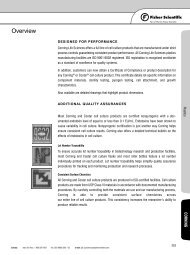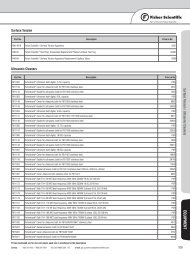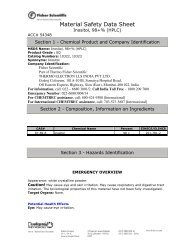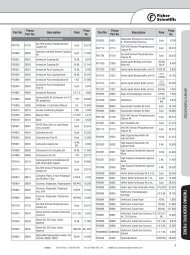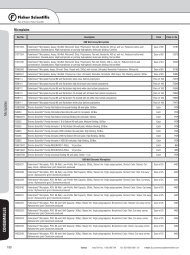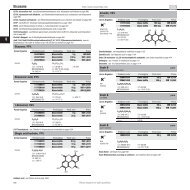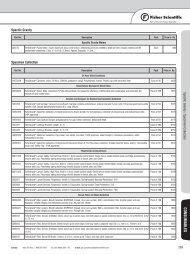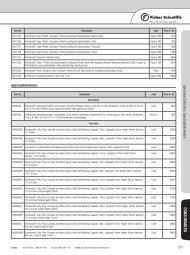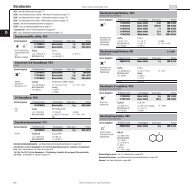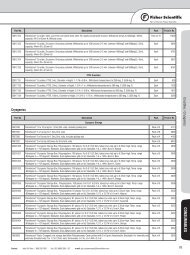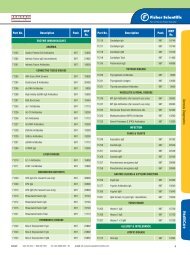Material Safety Data Sheet - Fisher Scientific: Lab Equipment
Material Safety Data Sheet - Fisher Scientific: Lab Equipment
Material Safety Data Sheet - Fisher Scientific: Lab Equipment
You also want an ePaper? Increase the reach of your titles
YUMPU automatically turns print PDFs into web optimized ePapers that Google loves.
ACC# 00345<br />
<strong>Material</strong> <strong>Safety</strong> <strong>Data</strong> <strong>Sheet</strong><br />
Cadmium sulfate, 8/3-hydrate<br />
Section 1 - Chemical Product and Company Identification<br />
MSDS Name: Cadmium sulfate, 8/3-hydrate<br />
Product Grade : SQ<br />
Catalog Numbers: 22084, 22085<br />
Synonyms: Cadmium Sulphate<br />
Company Identification:<br />
<strong>Fisher</strong> <strong>Scientific</strong><br />
Part of Thermo <strong>Fisher</strong> <strong>Scientific</strong><br />
THERMO ELECTRON LLS INDIA PVT.LTD.<br />
Godrej Coliseum, 101A-101B, Somaiya Hospital Road,<br />
Off Eastern Express Highway, Sion (East), Mumbai-400 022, India<br />
For information, call: 022 – 6680 3001/2, Call India Toll Free – 1 800 209 7001<br />
Emergency Number: 022-66803004/14<br />
For CHEMTREC assistance, call: 800-424-9300 [International]<br />
For International CHEMTREC assistance, call: 703-527-3887 [International]<br />
Section 2 - Composition, Information on Ingredients<br />
CAS# Chemical Name Percent EINECS/ELINCS<br />
7790-84-3 Cadmium sulfate, 8/3-hydrate 100 unlisted<br />
Section 3 - Hazards Identification<br />
EMERGENCY OVERVIEW<br />
Appearance: white crystals.<br />
Danger! Danger of serious damage to health by prolonged exposure through<br />
inhalation and if swallowed. Cancer hazard. Harmful if swallowed. Causes eye, skin, and<br />
respiratory tract irritation. Contains cadmium. Avoid creating dust. May cause lung<br />
damage. May cause liver and kidney damage.<br />
Target Organs: Kidneys, liver, lungs, skeletal structures.
Potential Health Effects<br />
Eye: Causes eye irritation.<br />
Skin: Causes skin irritation. May be harmful if absorbed through the skin.<br />
Ingestion: Harmful if swallowed. Causes gastrointestinal irritation with nausea,<br />
vomiting and diarrhea. May cause unconsciousness.<br />
Inhalation: Effects may be delayed. Causes respiratory tract irritation. Irritation may<br />
lead to chemical pneumonitis and pulmonary edema. May cause dyspnea (difficult or<br />
labored breathing). May cause cough, chest pain, fever, muscular cramps, and<br />
headache.<br />
Chronic: May cause respiratory tract cancer. Prolonged or repeated exposure may<br />
cause permanent bone structure abnormalities. May cause liver and kidney damage.<br />
May cause anemia and other blood cell abnormalities. Chronic inhalation may cause<br />
pulmonary emphysema. Chronic inhalation may cause pulmonary fibrosis. Inhalation of<br />
dust may cause chronic rhinitis (inflammation of the mucous membrane of the nose).<br />
Section 4 - First Aid Measures<br />
Eyes: Immediately flush eyes with plenty of water for at least 15 minutes, occasionally<br />
lifting the upper and lower eyelids. Get medical aid imme diately.<br />
Skin: Get medical aid immediately. Immediately flush skin with plenty of water for at<br />
least 15 minutes while removing contaminated clothing and shoes.<br />
Ingestion: Call a poison control center. If swallowed, do not induce vomiting unless<br />
directed to do so by medical personnel. Never give anything by mouth to an unconscious<br />
person. Get medical aid.<br />
Inhalation: Get medical aid immediately. Remove from exposure and move to fresh air<br />
immediately. If not breathing, give artificial respiration. If breathing is difficult, give<br />
oxygen.<br />
Notes to Physician: Treat symptomatically and supportively.<br />
Antidote: The use of Calcium disodium EDTA as a chelating agent should be determined<br />
by qualified medical personnel.<br />
Section 5 - Fire Fighting Measures<br />
General Information: As in any fire, wear a self-contained breathing apparatus in<br />
pressure-demand, MSHA/NIOSH (approved or equivalent), and full protective gear.<br />
During a fire, irritating and highly toxic gases may be generated by thermal<br />
decomposition or combustion.<br />
Extinguishing Media: Substance is noncombustible; use agent most appropriate to<br />
extinguish surrounding fire.<br />
Flash Point: Not available.<br />
Autoignition Temperature: Not available.<br />
Explosion Limits, Lower:Not available.
Upper: Not available.<br />
NFPA Rating: (estimated) Health: 2; Flammability: 0; Instability: 0<br />
Section 6 - Accidental Release Measures<br />
General Information: Use proper personal protective equipment as indicated in<br />
Section 8.<br />
Spills/Leaks: Vacuum or sweep up material and place into a suitable disposal<br />
container. Clean up spills immediately, observing precautions in the Protective<br />
<strong>Equipment</strong> section. Avoid generating dusty conditions. Provide ventilation.<br />
Section 7 - Handling and Storage<br />
Handling: Wash hands before eating. Minimize dust generation and accumulation. Do<br />
not breathe dust, vapor, mist, or gas. Do not get in eyes, on skin, or on clothing. Do not<br />
ingest or inhale. Use only in a chemical fume hood.<br />
Storage: Store in a cool, dry place. Store in a tightly closed container.<br />
Section 8 - Exposure Controls, Personal Protection<br />
Engineering Controls: Facilities storing or utilizing this material should be equipped<br />
with an eyewash facility and a safety shower. Use adequate general or local exhaust<br />
ventilation to keep airborne concentrations below the permissible exposure limits.<br />
Exposure Limits<br />
Chemical Name ACGIH NIOSH OSHA - Final PELs<br />
Cadmium sulfate, 8/3hydrate<br />
0.01 mg/m3 TWA (as<br />
Cd); 0.002 mg/m3 TWA<br />
(respirable fraction, as<br />
Cd) (listed under<br />
Cadmium compounds).<br />
none listed<br />
2.5 æg/m3 Action Level<br />
(as Cd); 5 æg/m3 PEL<br />
(as Cd. Do not eat,<br />
drink or chew t obacco<br />
or gum or apply<br />
cosmetics in regulated<br />
areas. Carcinogen: dust<br />
can cause lung and<br />
kidney disease. See 29<br />
CFR 1910.1027) (listed<br />
under Cadmium<br />
compounds).
Cadmium sulfate<br />
0.01 mg/m3 TWA (as<br />
Cd); 0.002 mg/m3 TWA<br />
(respirable fraction, as<br />
Cd) (listed under<br />
Cadmium compounds).<br />
none listed<br />
2.5 æg/m3 Action Level<br />
(as Cd); 5 æg/m3 PEL<br />
(as Cd. Do not eat,<br />
drink or chew t obacco<br />
or gum or apply<br />
cosmetics in regulated<br />
areas. Carcinogen: dust<br />
can cause lung and<br />
kidney disease. See 29<br />
CFR 1910.1027) (listed<br />
under Cadmium<br />
compounds).<br />
OSHA Vacated PELs: Cadmium sulfate, 8/3-hydrate: No OSHA Vacated PELs are listed<br />
for this chemical. Cadmium sulfate: No OSHA Vacated PELs are listed for this chemical.<br />
Personal Protective <strong>Equipment</strong><br />
Eyes: Wear appropriate protective eyeglasses or chemical safety goggles as described<br />
by OSHA's eye and face protection regulations in 29 CFR 1910.133 or European<br />
Standard EN166.<br />
Skin: Wear appropriate protective gloves and clothing to prevent skin exposure.<br />
Clothing: Wear appropriate protective clothing to prevent skin exposure.<br />
Respirators: Follow the OSHA respirator regulations found in 29 CFR 1910.134 or<br />
European Standard EN 149. Use a NIOSH/MSHA or European Standard EN 149 approved<br />
respirator if exposure limits are exceeded or if irritation or other symptoms are<br />
experienced.<br />
Section 9 - Physical and Chemical Properties<br />
Physical State: Crystals<br />
Appearance: white<br />
Odor: odorless<br />
pH: 3-6 (50g/l aq.sol.)<br />
Vapor Pressure: Not available.<br />
Vapor Density: Not applicable.<br />
Evaporation Rate:Negligible.<br />
Viscosity: Not available.<br />
Boiling Point: Not available.<br />
Freezing/Melting Point:41 deg C<br />
Decomposition Temperature:> 80 deg C<br />
Solubility: 1130 g/l in water (20°C)<br />
Specific Gravity/Density:Not available.<br />
Molecular Formula:Cd3O12S . 2.7H2O<br />
Molecular Weight:256.52
Section 10 - Stability and Reactivity<br />
Chemical Stability: Stable.<br />
Conditions to Avoid: Incompatible materials, dust generation.<br />
Incompatibilities with Other <strong>Material</strong>s: Metals, oxidizing agents, zinc, selenium,<br />
tellurium, hydrogen azide, Violently reacts with magnesium and with aluminum powder<br />
when heated..<br />
Hazardous Decomposition Products: Oxides of sulfur, toxic cadmium oxide fumes.<br />
Hazardous Polymerization: Will not occur.<br />
RTECS#:<br />
CAS# 7790-84-3: EV2850000<br />
CAS# 10124-36-4: EV2700000<br />
LD50/LC50:<br />
Not available.<br />
CAS# 10124-36-4:<br />
Oral, mouse: LD50 = 47 mg/kg;<br />
Oral, rat: LD50 = 280 mg/kg;<br />
.<br />
Carcinogenicity:<br />
CAS# 7790-84-3:<br />
Section 11 - Toxicological Information<br />
• ACGIH: A2 - Suspected Human Carcinogen (listed as 'Cadmium compounds').<br />
• California: carcinogen, initial date 10/1/87 (listed as Cadmium compounds).<br />
• NTP: Known carcinogen (listed as Cadmium compounds).<br />
• IARC: Group 1 carcinogen (listed as Cadmium compounds).<br />
CAS# 10124-36-4:<br />
• ACGIH: A2 - Suspected Human Carcinogen (listed as 'Cadmium compounds').<br />
• California: carcinogen, initial date 10/1/87 (listed as Cadmium compounds).<br />
• NTP: Known carcinogen (listed as Cadmium compounds).<br />
• IARC: Group 1 carcinogen<br />
Epidemiology: NIOSH cited recent epidemiological evidence of a significant excess of<br />
respiratory cancer deaths among a cohort of cadmium production workers, and<br />
concluded that cadmium and its compounds are potential carcinogens.
Teratogenicity: Experimental teratogenic effects have been reported.<br />
Reproductive Effects: Experimental reproductive effects have been reported.<br />
Mutagenicity: Mutagenic effects have occurred in experimental animals.<br />
Neurotoxicity: No information found<br />
Other Studies:<br />
No information available.<br />
Section 12 - Ecological Information<br />
Section 13 - Disposal Considerations<br />
Chemical waste generators must determine whether a discarded chemical is classified as<br />
a hazardous waste. US EPA guidelines for the classification determination are listed in 40<br />
CFR Parts 261.3. Additionally, waste generators must consult state and local hazardous<br />
waste regulations to ensure complete and accurate classification.<br />
RCRA P-Series: None listed.<br />
RCRA U-Series: None listed.<br />
Section 14 - Transport Information<br />
Shipping Name: CADMIUM COMPOUNDS<br />
US DOT Canada TDG<br />
CADMIUM COMPOUND (CADMIUM<br />
SULFATE)<br />
Hazard Class: 6.1 6.1<br />
UN Number: UN2570 UN2570<br />
Packing Group: III III<br />
US FEDERAL<br />
Section 15 - Regulatory Information<br />
TSCA<br />
CAS# 7790-84-3 is not listed on the TSCA inventory. It is for research and<br />
development use only.
CAS# 10124-36-4 is listed on the TSCA inventory.<br />
Health & <strong>Safety</strong> Reporting List<br />
None of the chemicals are on the Health & <strong>Safety</strong> Reporting List.<br />
Chemical Test Rules<br />
None of the chemicals in this product are under a Chemical Test Rule.<br />
Section 12b<br />
None of the chemicals are listed under TSCA Section 12b.<br />
TSCA Significant New Use Rule<br />
None of the chemicals in this material have a SNUR under TSCA.<br />
CERCLA Hazardous Substances and corresponding RQs<br />
None of the chemicals in this material have an RQ.<br />
SARA Section 302 Extremely Hazardous Substances<br />
None of the chemicals in this product have a TPQ.<br />
SARA Codes<br />
CAS # 7790-84-3: immediate, delayed.<br />
CAS # 10124-36-4: immediate, delayed.<br />
Section 313<br />
This material contains Cadmium sulfate, 8/3-hydrate (listed as Cadmium<br />
compounds), 100%, (CAS# 7790-84-3) which is subject to the reporting requirements<br />
of Section 313 of SARA Title III and 40 CFR Part 373.<br />
This material contains Cadmium sulfate (listed as Cadmium compounds), -%, (CAS#<br />
10124-36-4) which is subject to the reporting requirements of Section 313 of SARA Title<br />
III and 40 CFR Part 373.<br />
Clean Air Act:<br />
CAS# 7790-84-3 (listed as Cadmium compounds) is listed as a hazardous air<br />
pollutant (HAP).<br />
CAS# 10124-36-4 (listed as Cadmium compounds) is listed as a hazardous air<br />
pollutant (HAP).<br />
This material does not contain any Class 1 Ozone depletors.<br />
This material does not contain any Class 2 Ozone depletors.<br />
Clean Water Act:<br />
None of the chemicals in this product are listed as Hazardous Substances under the<br />
CWA.<br />
None of the chemicals in this product are listed as Priority Pollutants under the CWA.<br />
CAS# 7790-84-3 is listed as a Toxic Pollutant under the Clean Water Act. CAS# 10124-<br />
36-4 is listed as a Toxic Pollutant under the Clean Water Act.<br />
OSHA:<br />
None of the chemicals in this product are considered highly hazardous by OSHA.<br />
STATE<br />
CAS# 7790-84-3 can be found on the following state right to know lists: California,<br />
(listed as Cadmium compounds), Pennsylvania, (listed as Cadmium compounds),<br />
Minnesota, (listed as Cadmium compounds).<br />
CAS# 10124-36-4 can be found on the following state right to know lists: California,<br />
(listed as Cadmium compounds), New Jersey, Pennsylvania, Minnesota, (listed as<br />
Cadmium compounds), Massachusetts.<br />
California Prop 65<br />
The following statement(s) is(are) made in order to comply with the California<br />
Safe Drinking Water Act:<br />
WARNING: This product contains Cadmium sulfate, 8/3-hydrate, listed as `Cadmium
compounds', a chemical known to the state of California to cause cancer. WARNING:<br />
This product contains Cadmium sulfate, listed as `Cadmium compounds', a chemical<br />
known to the state of California to cause cancer.<br />
California No Significant Risk Level: None of the chemicals in this product are listed.<br />
European/International Regulations<br />
European <strong>Lab</strong>eling in Accordance with EC Directives<br />
Hazard Symbols:<br />
T N<br />
Risk Phrases:<br />
R 22 Harmful if swallowed.<br />
R 49 May cause cancer by inhalation.<br />
R 48/23/25 Toxic : danger of serious damage to health by prolonged<br />
exposure through inhalation and if swallowed.<br />
R 50/53 Very toxic to aquatic organisms, may cause long-term<br />
adverse effects in the aquatic environment.<br />
<strong>Safety</strong> Phrases:<br />
S 22 Do not breathe dust.<br />
S 36/37 Wear suitable protective clothing and gloves.<br />
S 45 In case of accident or if you feel unwell, seek medical advice<br />
immediately (show the label where possible).<br />
S 61 Avoid release to the environment. Refer to special instructions<br />
/safety data sheets.<br />
WGK (Water Danger/Protection)<br />
CAS# 7790-84-3: No information available.<br />
CAS# 10124-36-4: 3<br />
Canada - DSL/NDSL<br />
CAS# 10124-36-4 is listed on Canada's DSL List.<br />
Canada - WHMIS<br />
This product has a WHMIS classification of D1A, D2A.<br />
This product has been classified in accordance with the hazard criteria of the Controlled<br />
Products Regulations and the MSDS contains all of the information required by those<br />
regulations.<br />
Canadian Ingredient Disclosure List<br />
CAS# 7790-84-3 (listed as Cadmium compounds) is listed on the Canadian<br />
Ingredient Disclosure List.<br />
CAS# 10124-36-4 is listed on the Canadian Ingredient Disclosure List.<br />
MSDS Creation Date: 3/06/2000<br />
Revision #5 Date: 11/03/2005<br />
Section 16 - Additional Information<br />
The information above is believed to be accurate and represents the best information currently available to us.<br />
However, we make no warranty of merchantability or any other warranty, express or implied, with respect to such<br />
information, and we assume no liability resulting from its use. Users should make their own investigations to
determine the suitability of the information for their particular purposes. In no event shall <strong>Fisher</strong> be liable for any<br />
claims, losses, or damages of any third party or for lost profits or any special, indirect, incidental, consequential or<br />
exemplary damages, howsoever arising, even if <strong>Fisher</strong> has been advised of the possibility of such damages.



